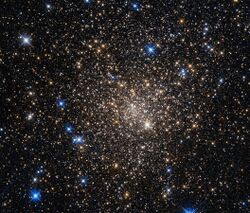Astronomy:Terzan 1
Coordinates: ![]() 17h 35m 47.80s, −30° 28′ 11.0″
17h 35m 47.80s, −30° 28′ 11.0″
| Terzan 1 | |
|---|---|
 Terzan 1 image taken with the Wide Field Planetary Camera 2 on board the NASA/ESA Hubble Space Telescope (north is to the right)[1] | |
| Observation data (J2000 epoch) | |
| Constellation | Scorpius[1] |
| Right ascension | 17h 35m 47.8s[2] |
| Declination | −30° 28′ 11.0″[2] |
| Physical characteristics | |
| Other designations | ESO 455-23, Cl Haute-Provence 2, Cl VDBH 235, [KPS2012] MWSC 2635, C 1732-304, Cl Terzan 1, GCl 69 |

Terzan 1 also known as ESO 455-23 and Terzan 1966, is a heavily obscured globular cluster located around 20.000 light-years from Earth in the constellation of Scorpius.
It is one of about 150 globular clusters discovered by the French astronomer Agop Terzan in the 1960s-70s, belonging to the Milky Way. Terzan 1 is also an X-ray source.
Terzan 1 has the smallest projected distance to the Milky Way’s center among all known globulars: is only 4,200 light-years from the center but 21,800 light-years from Earth.
In 1980, astronomers detected X-ray bursts from a source located in Terzan 1. Several years later, the source X1732-304 was detected within the cluster with NASA’s Spacelab 2 and ESA’s EXOSAT missions.[3]
References
- ↑ 1.0 1.1 "A home for old stars". http://www.spacetelescope.org/images/potw1550a/. Retrieved 15 December 2015.
- ↑ 2.0 2.1 "Search Result for Terzan 1". http://simbad.u-strasbg.fr/simbad/sim-basic?Ident=Terzan+1&submit=SIMBAD+search. Retrieved 15 December 2015.
- ↑ "Terzan 1: Hubble Snaps Breathtaking Picture of Globular Cluster | Sci-News.com" (in en-US). 14 December 2015. http://www.sci-news.com/astronomy/terzan1-hubble-globular-cluster-03509.html.
 |


